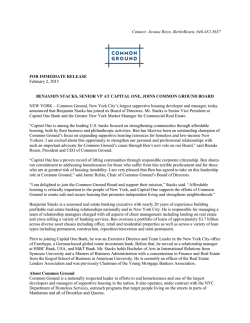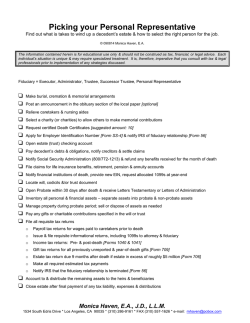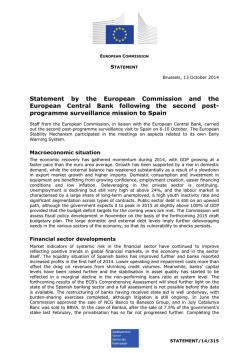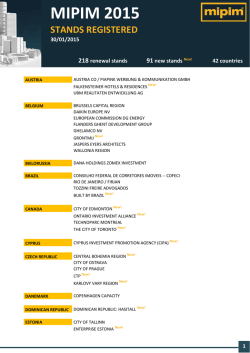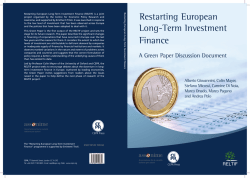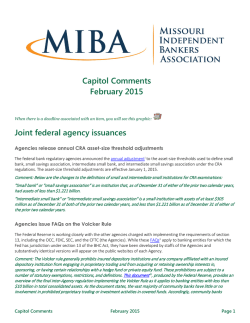
The German real estate market - Bank for International Settlements
Andreas Dombret: The German real estate market – cause for concern? Speech by Dr Andreas Dombret, Member of the Executive Board of the Deutsche Bundesbank, to Haus & Grund Deutschland, Berlin, 28 January 2015. * 1. * * Introduction Dear President Kornemann, Ladies and gentlemen It’s a great pleasure for me to speak to you today. I gladly accepted your invitation to Berlin given the important influence that you – along with the German tenants’ association “Deutscher Mieterbund” – have on the German real estate market. This is the first time I have taken part in your panel discussion, although I did once address the annual meeting of Haus & Grund in Frankfurt at the invitation of Mr Conzelmann. I am therefore pleased to have this opportunity to explain the Bundesbank’s perspective on the German real estate market. Let us begin by taking a look at the economic situation in general – after all, economic conditions impact strongly on the real estate markets. 2. German economy in good shape The German economic situation is not as bad as some might think. On the contrary, the German economy remains in good shape. Enterprises in Germany have their costs under control, their debt is not particularly high, and they have an attractive range of products to offer the global markets. Moreover, German economic activity is supported by consumption. Unemployment is low, households are not burdened by excessive debt and real wages are rising appreciably owing to low inflation. In our December forecast we expect Germany’s real gross domestic product to rise by 1.0% this year and 1.6% next year. However, the price of oil has fallen sharply since we prepared that forecast. If oil prices persist at their current low levels, economic growth could prove to be markedly higher this year and next, since the low price of oil has the effect of a small stimulus package. At the same time, we have for quite a while now been witnessing very low inflation rates, both in Germany and throughout the euro area. And we can expect them to continue for some time to come. This undoubtedly poses a serious challenge for monetary policymakers. After all, we seek to achieve for the euro area inflation rates of below but close to 2% over the medium term. To help us move closer to this target, the ECB Governing Council last Thursday adopted a programme for the purchase of government bonds. As you know, the Bundesbank takes a critical view of this government bond purchase programme. In our opinion, monetary policymakers are not under any acute pressure to act, as the low inflation rate is mainly attributable to falling energy prices. For the next two years, we are expecting inflation to pick up gradually; certainly, there is no sign of deflation. What is more, government bond purchases are not simply a monetary policy instrument like any other where the euro area is concerned. They entail risks which we believe are not outweighed by the expected effects. At least the ECB Governing Council has agreed on a number of constraints to curb balance sheet risks, so that there will only be joint liability for a small portion of the programme. This will mitigate at least some of the problems which government bond purchases entail. However, this additional monetary policy easing could have undesired side-effects. For instance, the low interest rates could encourage many investors, in their search for yield, to BIS central bankers’ speeches 1 turn to assets they previously avoided due to the associated risks. This makes the emergence of price bubbles more likely, which could cause problems for the stability of the financial system. And the real estate market is one of those markets where a search for yield can lead to exaggerations. That’s why it is worth taking a closer look at this market. 3. Real estate markets – an important part of the economy Price bubbles are always especially problematic when the purchase of the asset is financed, above all, through credit. Real estate is a case in point. Residential mortgage loans account for 43% of all loans to the private sector in Germany. Property prices and lending can develop mutually reinforcing, destabilising feedback effects. When prices in the real estate market rise, banks – in the assumption that this trend will continue – may grant additional credit, fuelling price increases further. Of course, that only goes well until the bubble finally bursts. The faster and lower prices then fall, the more loans cannot be repaid. This compromises the banks’ profits and stability – and when the banks sneeze, the whole economy catches a cold. The crises affecting other countries in recent years have made this patently clear. Which is why we are watching the real estate market very closely indeed. And this begs the question: do we see a price bubble in the German real estate market? Is there cause for concern? 4. The current situation in the real estate market – no bubble Three different circumstances would have to coincide for a price bubble to form in the real estate market. • First, a self-sustaining increase in prices which leads to prices that are no longer justified by economic fundamentals • Second, excessive growth in mortgage lending • Third, an easing of banks’ credit standards for mortgage loans Let us then consider the threat of a price bubble by examining these three ingredients. The first question is: do we see an excessive increase in prices? All in all, price dynamics in Germany over the past 20 years have been moderate compared with the rest of the euro area. However, we have seen prices climb fairly steeply in some parts of Germany since 2010 – although the rise in prices did slow down slightly in 2014. Since 2010, prices have risen by an average of 7% per year in Germany’s seven largest cities. Housing prices have increased in medium-sized towns and cities, too, although only by just over 5% per year. The equivalent figure for Germany as a whole is 3%. What we are seeing, then, are marked regional disparities with regard to price increases. Does that add up to a price bubble? For Germany as a whole, the answer is no. For the years 2010 onwards, we cannot identify any growing, substantial overvaluation of housing. The rise in prices reflects, at least in part, a catching-up process following a period of weak price growth that persisted for quite a number of years. However, we assume that residential properties were probably overpriced by as much as 20% in large and medium-sized towns and cities up to and including 2013, while overpricing in the seven major cities was probably even somewhat more pronounced in 2013. Price dynamics in the German housing market have, however, weakened appreciably. To sum up: property price developments present a mixed picture, but the bottom line is that it’s not particularly worrying. 2 BIS central bankers’ speeches What about the second ingredient for a property price bubble: lending? First of all, it has undoubtedly become easier to finance a property purchase thanks to high liquidity levels and low interest rates. Today it’s possible for investors to obtain funds at very favourable conditions over a very long period. The weighted average interest rate for new loans over all maturities is 2.3%. Another factor is the low returns on alternative investments, which are encouraging some to seek a crisis-proof, ostensibly safe and higher-yielding investment – turning real estate into what has been dubbed “concrete gold”. Yet investors should always bear in mind that higher yields are accompanied by higher risks. Thus, the volume of mortgage credit to households has risen steadily since 2010, albeit initially at a moderate pace. In November 2014, year-on-year growth was just shy of 2½%, and gathered pace in the last quarter in particular – in Germany even more so than in the euro area. On the whole, however, mortgage loans have not risen excessively. Purely in terms of volume, banks’ vulnerability has increased only slightly. Which brings us to the third ingredient of a price bubble: the credit standards by which mortgage loans are granted. Is the risk incurred by banks with new lending greater today than it was a few years ago? A survey of 116 selected German banks conducted by banking supervisors provides a more detailed picture. The survey in question focuses on 15 towns and cities where property price increases were particularly strong and nine where they were about average in the period 2009 to 2013. The findings present a picture of the impact of the dynamic price trend on lending activity. And here, too, we cannot see any signs of trouble brewing. On the contrary, the banks report that they did not ease their credit standards. Conditions were more favourable for some customers due to the further decline in interest rates; the risk premiums that the banks priced in remained stable, however. Ultimately, credit standards for loans to households for house purchase remained unchanged in Germany, while they were eased slightly in the rest of Europe. Yet this does not mean we can unreservedly sound the all-clear. This is because the special survey also reveals a fairly large share of loans with what we might refer to as high German sustainable LTV ratios (Hochausläufer) in the “attractive towns and cities” segment. With such mortgages, the loan is greater than the mortgage lending value, that is the value the bank calculates in respect of the property serving as collateral. Loans of this kind do not necessarily give cause for concern in each and every case: the borrower’s high level of available assets or income can have a risk-mitigating effect. Nevertheless, the fact that such loans account for a large share of all mortgages does indicate that there might be structural vulnerabilities in the German banking system to crises on the real estate market. The German Pfandbrief Act (Pfandbriefgesetz) restricts the German sustainable loan-tovalue ratio (Beleihungsauslauf) to 60% of the mortgage lending value for loans that are eligible as cover for mortgage Pfandbriefe. However, it is of limited effect as only one-tenth of residential mortgage loans are used to collateralise German mortgage Pfandbriefe. Building and loan associations implicitly limit the German sustainable LTV to 80%. Nevertheless, there is a lot of scope for mortgages with high German sustainable LTV ratios. Banking supervisors will be taking a closer look at this in future. 5. A look ahead – potential dangers Ladies and gentlemen, we have taken a look at three criteria for property price bubbles: price trends, lending and credit standards. And none of these point to destabilising developments. But the ECB’s decision to purchase government bonds on a grand scale has marked the beginning of a new era on the capital markets and we must bear this in mind. Liquidity is rising and interest rates are falling. Yet this means that there is also an increased risk of BIS central bankers’ speeches 3 asset price bubbles – not least on the real estate market. The world has thus become a rather more dangerous place for property investors. The situation on the real estate market also hinges on the currently relatively favourable macroeconomic environment. If macroeconomic conditions were to deteriorate and the default rates for residential mortgage loans were to rise, German banks would stand to make considerable losses. This is the conclusion that banking supervisors drew from the special survey that I mentioned earlier. We simulated various scenarios and found that, given an isolated shock on the real estate market, banks would still be able to meet regulatory capital requirements. If the banking environment were otherwise favourable, banks could compensate for an isolated shock of this nature with profits in other lines of business. However, an isolated shock on the real estate market is rather unlikely. Empirical studies for the United States and other OECD countries instead indicate that real estate markets and macroeconomic developments are closely interlinked. And in the event of a recession that extends beyond the real estate sector or even of a general financial crisis, cumulated losses could considerably impair banks’ internal capital adequacy. My colleague on the Executive Board, Claudia Buch, mentioned this back in November 2014 when we presented the Bundesbank’s latest Financial Stability Review. Looking further ahead, there is yet another danger looming that we must keep in mind: the possibility of an interest rate reversal. To address interest rate risk, borrowers are increasingly opting for long-term loans with fixed interest rates, while banks are able to adequately hedge against risks arising from these longer interest rate lock-ins. Nevertheless, both investors and banks must use the current low-interest-rate environment responsibly. And of course we should not forget that hedging against interest rate risk comes at a cost to banks. As a rule, loan contracts should only be signed if borrowers can continue to repay them even at higher rates of interest. And, in light of current events, there is another danger that we should not overlook – that of foreign exchange risk. The discontinuation of the minimum exchange rate for the Swiss franc and the subsequent appreciation thereof may create difficulties for borrowers who have taken out property loans in Swiss francs. If default rates were to rise, banks could run into difficulties. However, unlike in Austria or Poland for example, loans in Swiss francs play only a minimal role in Germany. According to current figures, property loans in Swiss francs account for only around €2 billion of the entire volume of property loans of over €1,000 billion in Germany. We thus see no need to be overly concerned. 6. What can we do? Even though the risks emanating from the real estate market currently appear to be low, we must still be prepared for all eventualities. Financial supervisors need to be prepared in case a bubble should emerge on the real estate market. It is thus crucial that we have tools at our disposal to contain the corresponding risks. This means that, in the end, it will be up to the central banks to step in and spoil the fun just as the party is in full swing. Over the past few years we have begun putting together such a toolbox. We are currently closely examining a number of new tools to ascertain the precise effect that they would have. However, before we can use such tools, we need a fitting legal basis. The central body for systemic financial supervision in Germany, the Financial Stability Committee, is working on this at the moment. In the next few months, it plans to present the Federal Government with recommendations on establishing a legal basis for the use of these instruments. 4 BIS central bankers’ speeches However, elected politicians are also currently planning measures which I believe are headed in the wrong direction from an economic perspective. The cap on rents that is to be introduced in the near future aims to protect tenants in “overstretched housing markets” against sharp rent increases. Wealth distribution considerations are clearly the prime motivation for this move. From an economic perspective, however, the measure is problematic as rising property prices are a sign of scarcity. They create an incentive to build new properties and thus increase the supply of housing. Regulatory intervention weakens this mechanism and thus ultimately prevents our society from having access to sufficient and affordable housing. From an economic perspective, I therefore do not believe that the cap on rents is a suitable means of combating potential excesses on the real estate markets. The same is true of political initiatives to limit the conversion of rented apartments into owner-occupied apartments. This would constitute a major intervention into property rights and would make it more difficult for existing tenants, who have the right of first refusal, to own property. 7. Conclusion Ladies and gentlemen, let us conclude. We started with the question: Is there currently a price bubble on Germany’s real estate market? For Germany as a whole, the answer is no. We do not believe the current price increases to be problematic, lending is not rising excessively and credit standards have not been eased. Based on these three criteria, we do not consider there to be a property price bubble. But, ladies and gentlemen, experience from other countries has shown that high liquidity and low interest rates create an environment which is often conducive to the formation of asset price bubbles. Thus the likelihood grows over time, and the ECB’s purchase of government bonds will only fuel this growth further. There is no storm raging now but the winds are picking up, and last week the work of banking supervisors became yet more challenging. But as Adam Posen, President of the Peterson Institute, said last week in an interview: “Germany must not take the rest of Europe hostage just to fight a bubble on its own housing market”. Instead he advised banking regulators and supervisors to address the problem directly. And that is precisely what we shall do. However, each and every investor is ultimately responsible for being risk-aware in their actions. And, according to a survey by Ernst & Young, the vast majority of property investors expect risk appetite to grow. I would caution against increasingly turning to risky investments to obtain that bit more profit while interest rates are low. At some point, interest rates will rise again, and then the financial burdens stemming from property loans will not be the only thing to increase. Both borrowers and lenders have a duty not to ignore this risk. In the current environment, banks should exercise particular caution when granting property loans. The Bundesbank will fulfil its responsibilities. We will continue to closely monitor the real estate market, mortgage lending and the banks granting these loans and take action as soon as necessary. Thank you very much. BIS central bankers’ speeches 5
© Copyright 2025
